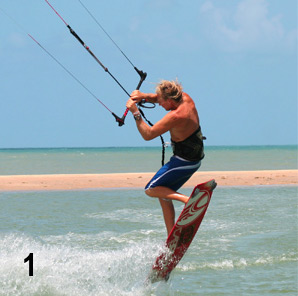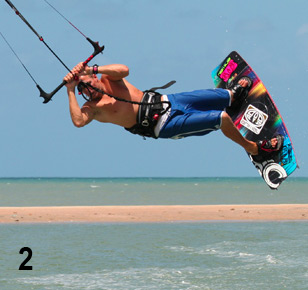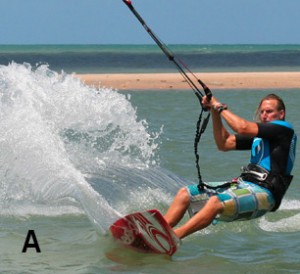Front Loop to Wrapped
Front Loop to Wrapped
This is a blind move for any aspiring freestylers. The “Front Loop to Wrapped” is an attainable pop move for anyone landing Shifty to Wrapped, also doubles your way to get into a non-inverted slim. Theoretically if you can perform a controlled unhooked front to toeside, then this move is just your step away.
 Pic 1 – From a front loop to toeside, you can see that the surfer has carved a long way upwind before popping. The result of this is that, regardless of how hard the fronts roll initiation it will have a stalling rotational speed effect at the start for the surfer to pop up into the rotation if needed. In short the surfer’s hands, bar and even the board are the way to a 360 degree rotation.
Pic 1 – From a front loop to toeside, you can see that the surfer has carved a long way upwind before popping. The result of this is that, regardless of how hard the fronts roll initiation it will have a stalling rotational speed effect at the start for the surfer to pop up into the rotation if needed. In short the surfer’s hands, bar and even the board are the way to a 360 degree rotation.
 Pic 2 – You can see that the surfer’s head and shoulders have all but completed rotation. The legs however are trapped in a time warp and are following some way behind. The point here is to forget your legs and as long as you are ready for the landing with your head and shoulders, the board will drop down toeside.
Pic 2 – You can see that the surfer’s head and shoulders have all but completed rotation. The legs however are trapped in a time warp and are following some way behind. The point here is to forget your legs and as long as you are ready for the landing with your head and shoulders, the board will drop down toeside.
Building Blocks
Approach
 Pic A – This should be a familiar scene for many of you, as we are the usual ingredients for good unhooked pop. The surfer has the kite parked somewhere 10:30 and 11:00 o’clock and carving hard upwind with the bum low, shoulders, back and arms are bent slightly. The bent arms are is a must to do this trick. The surfer’s front leg are pretty extended with hips over the back foot and back leg resisting for preparation to pop off once carving into the wind is applicable.
Pic A – This should be a familiar scene for many of you, as we are the usual ingredients for good unhooked pop. The surfer has the kite parked somewhere 10:30 and 11:00 o’clock and carving hard upwind with the bum low, shoulders, back and arms are bent slightly. The bent arms are is a must to do this trick. The surfer’s front leg are pretty extended with hips over the back foot and back leg resisting for preparation to pop off once carving into the wind is applicable.
Take-Off
Pic B – During the take-off you need to keep your arms in close. Popping up will make this a lot easier. You will also need to get the kite where it should be as the chances are it will rise slightly during your carving stage. Here you can see the surfer has popped up hard off using the back leg with hands close to the bar. The surfer has also steered the kite down a little by pulling on using front hand, which also helps the initiation of the rotation combined with dropped front shoulder at the same time to turn swiftly.
Waiting
Pic C – This picture sums the move up and also demonstrates the similarity between a shifty to wrapped, shifty 3 and the front to wrapped. With the rotation on going, the surfer focused on where to land while feet are catching up but still behind position. The objective here is to wait until you feel that your feet are dropping down because that is the sign to go for the wrapped. Timing is very important.
The Pull
Pic D – As mentioned, you’re the dropping of your leg is the signal to go for wrapped. The reason is you will be using the momentum of your dropping legs to bring them through and up to turn to a wrapped. Once they start to fall – use them!
The surfer here has reaction to the legs because of both hand pulling hard and aiming to go past the right hip while bringing the back (right) leg up towards the bar. If the kite is too high, the lift will make the landing and passing difficult. When pulling on the hands, it is a good idea to give the kite a little tweak down because it can make the rest of the move much easier. As soon as the surfer’s back knee comes up, other knee is bent, turn head with the rotation and let go with front hand, thus allowing the surfer to turn with the momentum on going.
The Landing
Pic E – Your aim is to get the board at least downwind but preferably a bit further around, so that you will keep your speed and move towards the kite to make the pass out of wrapped much easier. Continue to turn your head to look where you should be going. In the picture, the surfer almost has too much weight back, which can lead to bouncing on landing. As you come down, even though you released your front hand, you should carry on pulling the bar behind your back with your back hand and twist your wrist. This will place the bar correctly, and it will wait obediently for the pass.

Step by Step Sequence Summary
1. The surfer bears off the wind considerably, unhooks, drops weight and starts to carve into the wind.
2. The surfer aims to carve a long way up into the wind and keeps the hands in close.
3. As the kite starts to pull, the surfer pops up hard by extending back leg with all might while pulling hands down towards the body.
4. The surfer initiates the rotation by throwing front shoulder down towards the water and at the same time dips the kite by tweaking it with front hand.
5. In this position, the surfer can now rotate the head around, looking back over the trailing shoulder which will guarantee him enough rotation to get the way around the first loop.
6. With eyes focused on where to land, the surfer waits, timed, and doesn’t try to land quickly then he brings the legs around through the landing position.
7. As the legs start to drop, the surfer pulls hard on both hands, trying to rip the bar past the back hip, at the same time bringing the knees up towards the bar.
8. The surfer releases front hand and turns the head while keeping the knees up. Remember to twist as this will make your body rotate much easier.
9. Coming in for the landing as you can see that the surfer has the bar and wrist turns and ready, he turns the head to try and look where to land giving weight forward over the board.
10. The surfer lands with the board facing slightly off the wind and the arms wrapped around behind.
11. All that’s left to do is to reach behind with your free hand and pass the bar. The further you rotate the quicker you will need to do this as you will have more tension on the lines and the kite will rise.

Tips to Remember
1. Edge hard upwind
2. Keep hands in
3. Pop up over your hands to rotate
4. Lead with head and shoulders
5. Pull both hand hard past your back hip
Leave a Reply